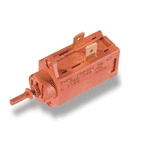 figure 1 - wax motor |
Like any appliance,there have been some Neptune breakdowns. While there are some fairly ordinary component failures, like timers and belts, bearings, switches and bulbs -common failure parts in any appliance design, there were a few notable issues which have attracted their share of attention concerning the Maytag Neptune.
 figure 1 - wax motor |
This is probably the most common and widely publicized failure - the wax motor in the door lock assembly fails, fries the machine controller, and the Neptune will not enter the spin cycle because the door no longer locks. Its failure is unique among electrical components, as it is a"soft" failure. Soft failures appear as temporary problems with a component,as opposed to "hard" failures which are permanent, and result in a dead component. The wax motor shorts out, and once the power goes away and the device cools down, the short is usually gone, and may or may not resurface for days, weeks, or months. At any rate, once the wax motor fails, the driver components on the main control board fry. Those are the hard failures. These are 1) Q6 - a MAC97A6 triac, and 2) R11 - a 3.9k ohm resistor. Consequently, this problem is referred to as the Q6/R11 or no spin failure in texts across the internet.
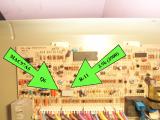 figure 2 - component locations |
The official recommended repair for this problem is replacement of the machine control board. To my knowledge, Maytag has not historically recommended replacement of the wax motor. The control board can cost roughly $150-200 on the open market. Electronically inclined individuals with good soldering skills can replace the MAC97A6 triac and the 3.9k ohm resistor for under $5.
When this failure occurs, the wax motor needs to be replaced as well, to the contrary of many claims, since it really is the root cause of the failure.The same device is seeing increasingly common appliance usage, from washing machines to dishwashers, to wherever an engineer can look for a cheap, reliable replacement for a solenoid or motorized actuator. Newer parts do not seem to have the failure rates that have been prevalent in the early Neptune door latch, so a replacement with a newer part is prudent, regardless. These wax motors can be found for around $16 at online appliance part suppliers, whereas the entire door latch assembly (original Maytag part 22002918 or 22003465, replaced by part 22003467) for about $75 online.
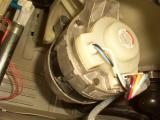 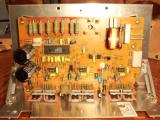 figure 3 - motor and controller |
Motors are a vital part of most appliances. An important consideration of the Neptune is that the drive motor be capable of high torque, high speed, soft starts, rapid reversal, and tight control. Criteria such as this can be expensive to obtain, driving up the cost of the appliance. Maytag enlisted Emerson Electric to help with the design of a motor and controller which could meet these requirements at a low cost. They selected a switched reluctance motor because of the control available, and the low manufacturing cost of the motor. Since the rotating component of the motor (rotor) has only vanes and no magnets or windings, it is cheaper than other motor designs. Unfortunately, this type of motor requires more sophistocated electronics for control; however, the electronics could be developed more cheaply than another type of motor which could perform under the same criteria. Another issue is the need for position feedback from the motor to the controller. This motor uses a tachometer device to inform the motor control board of the current rotor position, so that the controller may energize the proper phases at the proper times. This tach is sensitive to heat and vibration, and reports of tach failures have convinced me that it is likely the root cause in catastrophic failures of the control board, causing the output drivers (IRF-644 MOSFET) to fire at the wrong time, and in turn, causing one or more of them to short-circuit. These are the failures that result in a blown fuse on the motor control board, and usually this is terminal to the board.
Sometimes, there are failures of the control board which leave the fuse intact. These are typically from one or more of the output drivers dying as an open circuit. Open drivers typically do not cause co-lateral damage among the neighboring components, and replacement of the open MOSFET will generally repair the board.
Maytag has redesigned this subsystem, and now specifies a different motor and control board. I believe that most replacement motors in the channel have been replaced by the new model, but the original control board is generally still available. Ironically, the board carries a 1 year warranty, whereas the motor has a 10 year warranty. What does all this mean for you? Well, if you have a problem with the control board, and your machine is a year or two old, you're on your own. If, however, you have a motor problem (within 10 years, of course), then the fix under warranty is to replace the motor and control board, since the new motor must be subbed for the original, and naturally, it requires a new board.
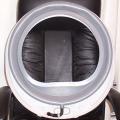 figure 4 - new drum seal design |
Front loading washing machines are different. They have a tub of water, which, when tipped over on its side, isn't supposed to leak. The key to this is a very pliable rubber seal that sits between the inner tub, which spins, and the outer tub, which doesn't. Maytag and Medibeg did an innovative job on this one, but it seems that there is a propensity for this seal to hold moisture in the "fold". This has allowed a lot of mold/mildew/slime to flourish and grow in Maytag Neptunes the worldover. Newer versions included a drain tube at the bottom of the boot for better drainage.
Back to the Beginning:> the Neptune